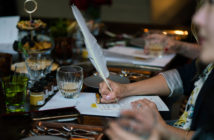In his new endeavor, Steven Smith Teamakers, Smith seeks to transform the expected into something fresh and new. Steven Smith’s creativity has made him one of the most successful innovators in tea.
On a quiet street in a city officially nicknamed “Beertown,” Steven Smith is at work in his combination lab, production facility, and tasting room in downtown Portland, Oregon. Smith is not creating liquid bread, but transforming familiar teas into new creations for his latest brand, Steven Smith Teamaker.
“In some cases, you have to prepare the water for tea,” he explains. In this instance, peaches and cherries are steeped in water to release their essences, then removed before infusing tea leaves in the fruit-water. A dip of his trusty tasting spoon, a few slurps, and he knows if he has found the right mix.
Smith is looking for that bridge between the familiar and the new — classics with a fresh take. “We want to do the traditional teas well, but we also aim to give tea drinkers something they don’t yet know they want.”
Smith, the co-founder of both Stash Tea and Tazo Tea, is not new to the game of putting a spin on the familiar. While working at Stash Tea, a customer requested a tea blend they had not yet created. Not one to turn down a creative challenge, Smith went into the back room to gather tools and herbs at hand. A hammer, work board, and paper cutter were employed to combine ingredients, including hibiscus and lemongrass. Smith carried his blend out front to the customer. The customer soon returned, wanting more.
Another time, he gave mint growers a new market by buying their crop and reselling it in bulk to tea blenders like Celestial Seasonings and Lipton. Previously, mint farmers had little choice but to sell their crop (at lower prices) for extraction of mint oil. U.S. tea blenders who had been importing mint from as far as Asia or Africa now had a fresher, more aromatic ingredient.
There can be too much of a good thing. Too many new teas could overwhelm a store’s shelves (not to mention a customer) with option overload. Smith concedes there are already a lot of tea options on supermarket shelves, but the selection is not necessarily what tea drinkers are looking for. Many tea drinkers are willing to move upward to a higher-priced, better quality tea. “Tea will continue to get more respect as brands put more effort into the quality of their ingredients,” predicts Smith.
In his Portland tasting room, an old Lipton tea caddy holds tasting spoons. Guests use these spoons to get a firsthand experience of tea quality. “Let the ingredients do the talking,” Smith asserts. He sees how people react to good quality teas, but also knows they want more. So Smith is among those leaders in the field who also advocate traceability of ingredients. The Smith Teamaker website allows you to enter a batch number placed on each box of tea he sells. Each batch number tells the back story of when and where the ingredients of that tea originated.
Smith demands higher quality, but he doesn’t necessarily aim to suit everyone’s palate. As he sees it: “If you try to appeal to everyone, you lose your edge.” He also feels that encouraging creativity within his team is critical. It was his colleagues and co-workers who helped him start experimenting with scenting teas in whiskey and wine barrels. He finds inspiration from the worlds of cooking and artisanal foods.
The ultimate goal is a well-curated selection of teas that combine better quality and distinctive character. Once this is achieved, Smith tries to avoid the sin of over-optimization. Refinements to a tea’s recipe may be necessary, but he is unwilling to substitute or reduce ingredients for the sake of cost savings. No repenting once the formula is just right. This sentiment carries through many aspects of Smith’s life, a man who prizes a favorite matcha bowl despite its crack. The bowl is just right — the optimal feel and aesthetic for his ritual tea experience. Why repent by replacing a trusted, beautiful cup? Besides, the crack adds to the bowl’s uniqueness. In the end, maybe creativity is not always about making new things as about helping something familiar like tea develop in novel ways.




